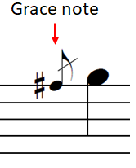The songs in this collection are designed to be easy to play.
Beginning guitar, piano keyboard, and ukulele players can easily pick out the single notes of the melody.
Players can also play the chords. The chord names are shown above the treble clef. For novice guitar players, guitar diagrams are also shown above the treble clef.
There are no complicated repeats or “skips,” just the sequential left to right flow of notes.
Most tunes are written in the key of C major, so there are no implicit sharps or flats to remember.
The left hand chords and rhythms are repetitive and consistent.

Notation
This book is designed to use as few special musical symbols as possible. The following summarizes the use of musical symbols. If you encounter a notation in this book that puzzles you, you should find its description below:
Types of Notes
There are four basic types of notes:
Whole note (an empty oval with no stem) get 4 counts
Half note (an empty oval with a stem that may point either up or down) ) get 2 count.
Quarter note (a filled oval with a stem that may point either up or down) gets 1 count.
Eighth note (a filled oval with a flag on it stem that may point up or down) gets 1/2 count. If one quarter note follows another, their flags maybe combined as a bar:

The following illustrates how many of each type of note can fit into a measure denoted as 4/4:

Rests
A rest is when you do not play a note. Like notes, rests can be different lengths. A hole rest gets four counts, a half rest gets two counts, a quarter rest gets one count, and an eighth rest gets one-half count.
Note Names
Most English speakers prefer to use the names of the alphabet characters to name note. Below are the names of the notes in a frequently used scale (a sequence of notes) called the C Major scale:

The above also illustrates the use of the time signature, the two fours. The bottom 4 indicates at quarter notes each get one count. The top 4 indicates that there are four counts to a measure (the notes between to vertical bars).
Sharps and Flats
Some notes have special symbols that indicate you should play a neighbor note instead of the note itself. These notes are flat notes (play the lower neighbor) or sharp notes (play the upper neighbor):

Grace Note
A grace note is a short note, so short that it does not have a count. It is represented by a small quarter note with a diagonal line through it:

Dotted note
Finally, a dotted note has a count of one and a half times of the note that is dotted. For example, this dotted half note gets a count of three instead of two:
